|
|
|
Sort Order |
|
|
|
Items / Page
|
|
|
|
|
|
|
| Srl | Item |
| 1 |
ID:
162789
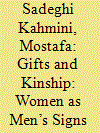

|
|
|
|
|
| Summary/Abstract |
This essay investigates the Iranian film ʿArus-e Ātash, directed by Khosrow Sināʾi in 1999, through the lens of gender studies. In doing so, it employs Claude Lévi-Strauss’ theory of kinship and elementary structures in order to create a context for the social structure of ʿashira as the prevailing unit of society among Khuzestāni Arabs of Iran. The significance of gift exchange as the predominant form of making alliances, as well as the position of women as the nucleus of these exchanges, is further discussed to shed light on the different socialization of male and female individuals in the ʿashira. Using Lévi-Strauss’ ideas in conjunction with the gender feminism of Kate Millett and Catharine A. MacKinnon, the study explores how women in primitive societies have the dual function of being the men’s property on an objective level as well as the means for alliance-making on a subjective one—a sign and a value at the same time. The essay concludes that men can also be considered as the victims of the patriarchal system since it creates a cultural image of men imbued with excessive masculinity that they may not be able live up to.
|
|
|
|
|
|
|
|
|
|
|
|
|
|
|
|
| 2 |
ID:
162783
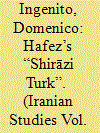

|
|
|
|
|
| Summary/Abstract |
This article constitutes a preliminary attempt to explore the geographical dimension of premodern Persian lyric poetry from the perspective of the relationship between the historical adherence of a text to external reality and the rhetorics of intertextuality and performativity. The pretext for this exploration is the poem known as “Tork-e Shirazi” or “The Turk from Shiraz,” one of the most celebrated ghazals of Hafez of Shiraz. The analysis focuses in particular on the first two lines of the ghazal, whose rich and ambiguous imagery has challenged the community of readers, interpreters, and scholars for centuries. On the basis of historiographical, formalist, and poststructuralist approaches to the study of lyric poetry, the article outlines a generative paradigm that analyzes a given text from the perspective of its abstract, genre-specific, conventionally negotiated, and referential levels of meaning. The contribution of geocritical studies will be combined with rhetorical analysis to conceive of Hafez’s text as a geopoetic map in which the cities of Shiraz, Samarkand, and Bukhara are put in conversation with the mental and historical representations of Iran and India between the thirteenth and fourteenth centuries, during the transition from the Mongol to the Timurid models and ideals of power.
|
|
|
|
|
|
|
|
|
|
|
|
|
|
|
|
| 3 |
ID:
162782
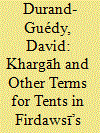

|
|
|
|
|
| Summary/Abstract |
This article aims to contribute to the wider debate on the historicity of the Shāh-nāmah by focusing on the way Firdawsī uses the word khargāh. The word, which is first attested in Rūdakī poetry, has not been dealt with adequately in previous scholarship dedicated to the Shāh-nāmah. An analysis of all the occurrences in the text provides results consistent with those obtained from contemporary sources: the khargāh appeared in Central Asia (here, Tūrān); it was the standard dwelling of Turkic-speaking pastoral nomads (here, Tūrānians), whatever their social rank; and it was adopted later as a status symbol by non-Turkish elites (here, during Kay-Khusraw’s reign). In Firdawsī’s Shāh-nāmah khargāh should therefore also be understood as the type of framed tent known as “trellis tent” (the so-called yurt).
|
|
|
|
|
|
|
|
|
|
|
|
|
|
|
|
| 4 |
ID:
162786
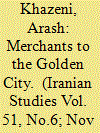

|
|
|
|
|
| Summary/Abstract |
This paper provides a translation and analysis of Sloane Mss. 3259 in the British Library, a Persian farmān from the court of King Chandrawizaya Rājā in the Arakanese Kingdom of Mrauk U (1429−1784). Written in 1728 and addressed to the Armenian merchant Khwājeh Georgin of the port of Chennaipattana across the Bay of Bengal in India, the decree is a permit for the lucrative trade in elephants and ivory from the forests of Arakan. The royal decree reveals the presence of Persian as a mutual language of encounter, exchange, diplomacy, and correspondence in eighteenth-century Southeast Asia. Through the manuscript, a view emerges of a sovereign forest kingdom of manifold rarities at the margins of the Persianate and Mughal worlds.
|
|
|
|
|
|
|
|
|
|
|
|
|
|
|
|
| 5 |
ID:
162784
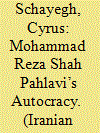

|
|
|
|
|
| Summary/Abstract |
Even when Mohammad Reza Shah became an autocrat by the early 1960s, systemic constraints on his power persisted. One was government officials. They certainly accepted the shah’s governmental centrality. But in parallel they inventively created more elbowroom for themselves than they are normally credited for, shaping everyday administration and co-shaping policies. The article substantiates this argument in two steps. First, it looks at Iran’s Sāzmān-e bimeh-hā-ye ejtemāʿi-ye kārgarān (Workers Social Insurance Organization [SBIK]), drawing principally on French-language International Labor Organization (ILO) archival files. Although the shah had a well-publicized stake in social insurance expansion, the SBIK influenced policy strategy, sometimes against his explicit wishes; also, it handled routine operations and relations with the ILO independently from him. Second, the article zooms out to analyze Persian-language Harvard University Iranian Oral History Project interviews with high-ranking officials, alongside other published and unpublished sources, to show how government officials maintained some autonomy vis-à-vis the shah. Their strategies included self-effacement, the agreement on a unified cabinet policy position before a royal audience, resignation threats, open pushback, and gifts, including favors, to third parties.
|
|
|
|
|
|
|
|
|
|
|
|
|
|
|
|
| 6 |
ID:
162788


|
|
|
|
|
| Summary/Abstract |
The document presented in this article is a quasi-ethnographic account of the religious customs of the Magh (i.e. Arakanese), which was most probably collected on the basis of firsthand observations made in the region of Chittagong, in southeastern Bengal, sometime in the 1780s, or early 1790s. The commissioner of the document is John Murray-MacGregor (1745–1822), a Scottish officer of the British East India Company, who remained in Bengal for about three decades and brought back with him one of the largest private collections of Persian manuscripts, as well as some bilingual Sanskrit–Persian texts, and twenty-two bundles of Pali and Arakanese manuscripts collected in eastern Bengal.
|
|
|
|
|
|
|
|
|
|
|
|
|
|
|
|
| 7 |
ID:
162785


|
|
|
|
|
| Summary/Abstract |
Through migration, professional activism, and by engaging the symbolic terrain of architecture magazines and competitions, Iranian architects have sought to make their profession cosmopolitan. But following decades of isolationist tendencies, factions of the Iranian architecture profession continue to meet resistance from elements of the state. The profession’s institutions have become a battleground for the expression of the power of design professionals. Building on scholarship on relationships between states and professions as well as professionals’ expressions of cosmopolitanism, this paper demonstrates ways everyday professionals leverage their institutions for professional power. It shares accounts from a transnational ethnography of Iranian architects to show how, on the one hand, professional change seeps outside restrictions attributed to political and economic borders. On the other hand, the stories of cosmopolitan professionals show that the state need not be bound by structural sanctions, like those Iran has faced, in its efforts to cultivate an avant-garde.
|
|
|
|
|
|
|
|
|
|
|
|
|
|
|
|
|
|
|
|
|